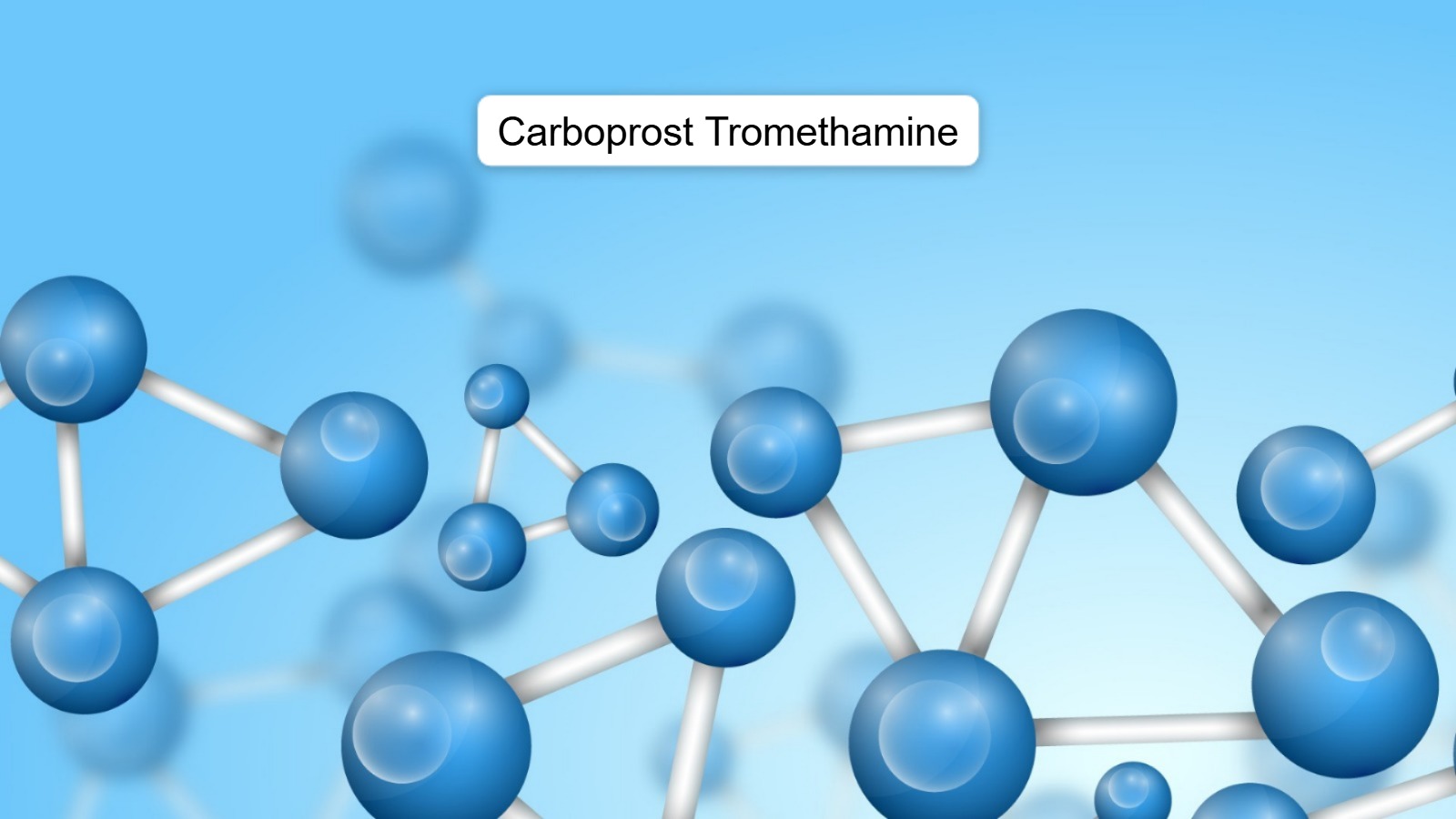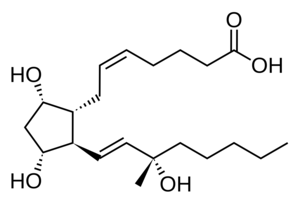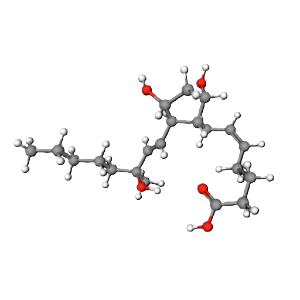
Carboprost Tromethamine is a synthetic prostaglandin analog commonly used in obstetrics to manage postpartum hemorrhage and induce abortions. Its unique structure, chemical properties, and mechanism of action make it an essential medication in gynecology. This guide explores Carboprost Tromethamine’s structure, properties, pharmacology, uses, and safety profile.
1. Structure of Carboprost Tromethamine
Understanding the molecular structure of Carboprost Tromethamine is key to understanding its efficacy in clinical applications.
2D Structure
The 2D structure of Carboprost Tromethamine shows its prostaglandin analog backbone, which includes a carboxylic acid group and a cyclopentane ring. These features are critical for its activity in inducing uterine contractions.

3D Structure
The 3D conformation of Carboprost Tromethamine reveals its spatial arrangement, allowing selective binding to prostaglandin receptors. This precise interaction enhances its ability to stimulate uterine smooth muscle contractions effectively.

2. Names and Identifiers
Carboprost Tromethamine is well-documented under various names and identifiers.
- IUPAC Name:
5-(3-hydroxy-2-(3-hydroxy-1-octenyl)-cyclopentyl)-3-hydroxy-2-(3-hydroxypropyl)-cyclopentanone tromethamine salt - Molecular Formula:
C25H47NO8 - Molecular Weight:
489.65 g/mol - CAS Registry Number:
58551-69-2 - Synonyms:
Hemabate, Carboprost
These identifiers facilitate its recognition in medical and pharmaceutical databases.
Explore a leading manufacturer of APIs.
With over 10 years of expertise, we ensure GMP compliance and provide reliable, high-quality solutions.
3. Chemical and Physical Properties
Carboprost Tromethamine’s chemical and physical properties play a significant role in its clinical effectiveness.
| Property | Details |
|---|---|
| Appearance | White to off-white crystalline powder |
| Solubility | Soluble in water and alcohol |
| Melting Point | ~120°C |
| Chemical Class | Prostaglandin Analog |
These properties allow its formulation for intramuscular administration.
4. Drug and Medication Information
Carboprost Tromethamine is primarily used in obstetrics for life-threatening conditions and specific medical procedures.
Formulations
- Injection:
- Available in 250 mcg/mL for intramuscular use.
Mechanism of Action
Carboprost Tromethamine works by:
- Stimulating Uterine Contractions: Mimics the action of natural prostaglandins to control postpartum bleeding and induce labor.
- Reducing Blood Loss: Enhances uterine tone to constrict blood vessels and minimize hemorrhage.
Dosage and Administration
- For Postpartum Hemorrhage: Administer 250 mcg intramuscularly. Repeat every 15-90 minutes if necessary, with a maximum dose of 2 mg.
- For Termination of Pregnancy: Administer as directed by a physician, typically in a clinical setting.
Always follow medical guidelines for proper administration.
5. Pharmacology and Biochemistry
Carboprost Tromethamine’s pharmacological profile underscores its targeted action in obstetrics.
Pharmacokinetics
- Absorption:
Rapidly absorbed after intramuscular injection. - Bioavailability:
High systemic availability due to direct administration. - Half-Life:
~8 minutes, with prolonged uterotonic effects. - Metabolism:
Metabolized in the liver and excreted primarily in urine.
Pharmacodynamics
Carboprost Tromethamine binds to prostaglandin F2α receptors on uterine smooth muscle, triggering powerful contractions. This action effectively controls bleeding and induces abortion.
6. Uses and Side Effects
Primary Uses
- Postpartum Hemorrhage:
Treats severe bleeding after childbirth by inducing uterine contractions. - Induction of Abortion:
Used for therapeutic abortion in the second trimester.
Benefits
- Rapid action in controlling postpartum hemorrhage.
- Effective for terminating pregnancy in medical settings.
Side Effects
Common side effects include:
- Nausea, vomiting, and diarrhea.
- Flushing or sweating.
- Temporary fever or chills.
Rare but serious side effects:
- Bronchospasm.
- Hypertension.
- Severe uterine cramps.
Seek immediate medical attention if serious side effects occur.
7. Safety and Hazards
Safety Profile
Carboprost Tromethamine is safe when used as directed in clinical settings. However:
- Contraindications: Not suitable for patients with active pelvic inflammatory disease, asthma, or hypersensitivity to prostaglandins.
- Pregnancy: Only used in specific cases under medical supervision.
Chemical Safety

Handling Precautions
- Store at 2–8°C (refrigerated).
- Avoid direct contact; handle with gloves.
Environmental Impact
Due to its clinical use, Carboprost Tromethamine has minimal environmental impact when disposed of according to medical waste guidelines.
Chemignition Laboratory is a globally trusted manufacturer and exporter of Carboprost Tromethamine Active Pharmaceutical Ingredients (API).
We specialize in APIs and provide complete documentation support including,
- GMP Certificate
- COA
- MSDS
- Stability Data
- Impurity Profile
- ISO 9001 Certificate
Customized packaging and cold chain logistics ensure safe delivery of sensitive APIs worldwide.
We proudly serve pharmaceutical companies across the USA, Europe, Asia, and more.
Partner with Chemignition Laboratory for consistent quality, regulatory compliance, and reliable global supply.
FAQs
IUPAC Name of Carboprost Tromethamine?
5-(3-hydroxy-2-(3-hydroxy-1-octenyl)-cyclopentyl)-3-hydroxy-2-(3-hydroxypropyl)-cyclopentanone tromethamine salt.
Molecular Formula Carboprost Tromethamine?
C25H47NO8
Molecular Weight Carboprost Tromethamine?
489.65 g/mol
CAS number of Carboprost Tromethamine?
58551-69-2
Synonyms Carboprost Tromethamine?
Hemabate, Carboprost
What is Carboprost Tromethamine used for?
Carboprost Tromethamine is primarily used in:
- Postpartum Hemorrhage (PPH): To control severe bleeding after childbirth.
- Induction of Abortion: For therapeutic abortion in the second trimester.
How does Carboprost Tromethamine work?
Carboprost Tromethamine mimics the natural prostaglandin F2α, stimulating uterine contractions and reducing blood loss by tightening uterine blood vessels.
